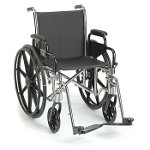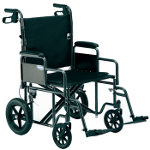The Wheelchair Guide
Your Wheelchair and Mobility Scooter Resource
Manual Wheelchairs for Seniors
Monday, May 18th, 2009 at 8:39 am
For a senior, walking for extended periods of time can often be very difficult, which is often the result of injuries or in some cases diseases, such as arthritis. Finding a way to increase accessibility and mobility is very important and often a manual wheelchair will offer the least expensive option for a senior.
A Brief Introduction to Manual Wheelchairs
 The wheelchair is probably the most well recognized and well known mobility aid, and its origins can be traced back many thousands of years. However, the modern wheelchair, with its steel tubed frame, two large wheels in back, and smaller wheels in front, is actually a fairly recent inventions. These manual wheelchairs, which can be found at virtually any hospital, store, or airport, are based off of the E & J wheelchair, which was first developed and refined during the 1920′s and 30′s.
The wheelchair is probably the most well recognized and well known mobility aid, and its origins can be traced back many thousands of years. However, the modern wheelchair, with its steel tubed frame, two large wheels in back, and smaller wheels in front, is actually a fairly recent inventions. These manual wheelchairs, which can be found at virtually any hospital, store, or airport, are based off of the E & J wheelchair, which was first developed and refined during the 1920′s and 30′s.
The E & J wheelchair, which features lightweight steel tubing and can be easily folded to make transportation easier, is still around today and serves as the basis for most manual wheelchairs. In fact, early electric wheelchairs also used the E & J design. Today there are many adaptations of the E & J wheelchair and many improvements have been made to increase durability, reduce weight, and improve comfort.
Seniors and Manual Wheelchairs
For a senior, a manual wheelchair is often one of the easiest ways to make getting from point a to point b easier. However, using a manual wheelchair requires a good deal of upper body strength, so as a result, most seniors who use manual wheelchairs rely on a family, friend, or caretaker member to push the wheelchair.
Due to their lightweight and lower cost, manual wheelchairs do make an excellent choice for traveling or going places, like an amusement park, where a lot of walking is required. This is of course, as long as there is someone available to operate the wheelchair.
In addition to the large rear wheels and smaller front wheels, manual wheelchairs also include anti-tip casters. Ant-tip casters extend from the rear of the wheelchair, usually at least six inches from the ground. In the event that the wheelchair is tipped backwards, the anti-tip casters make contact with the ground, keeping the wheelchair from completely tipping over.
Seniors and Transport Chairs
 If the senior is not going to be using the wheelchair at all, transport wheelchair, which are also called transfer chairs, are available as well. A transfer chair is similar to a wheelchair, however it does not feature the large rear wheels, which make it possible for the wheelchair user to roll the chair independently, but are instead designed to make it easier for a caretaker or family member to roll the wheelchair. These are often a good choice because they are typically lighter and smaller, making them easier for a caretaker to use.
If the senior is not going to be using the wheelchair at all, transport wheelchair, which are also called transfer chairs, are available as well. A transfer chair is similar to a wheelchair, however it does not feature the large rear wheels, which make it possible for the wheelchair user to roll the chair independently, but are instead designed to make it easier for a caretaker or family member to roll the wheelchair. These are often a good choice because they are typically lighter and smaller, making them easier for a caretaker to use.
Pros and Cons of Manual Wheelchairs for Seniors
While manual wheelchairs or transfer chairs are often the easiest type of mobility aid to procure and are also often the most cost effective option, for a senior, they are often not the easiest type of mobility aid for a senior to use.
For use around the home, it could be a good choice, as they are very maneuverable and in such a small area, it would not require too much effort to use the chair. For long distances though, using a manual wheelchair could quickly become tiring for a senior, so manual wheelchairs might not provide the best choice for a senior who lives independently.